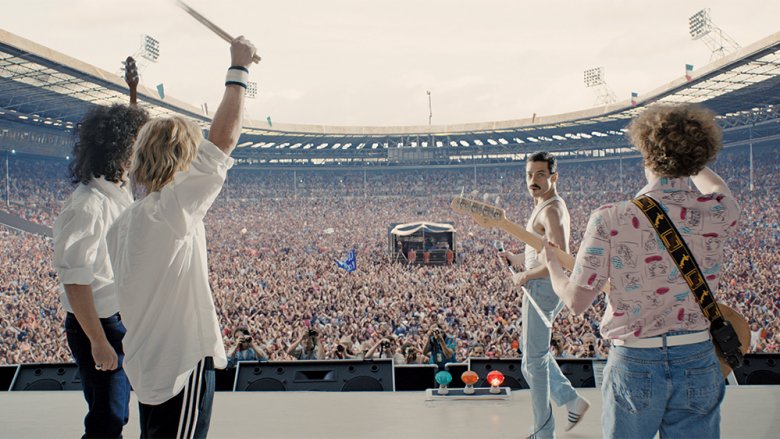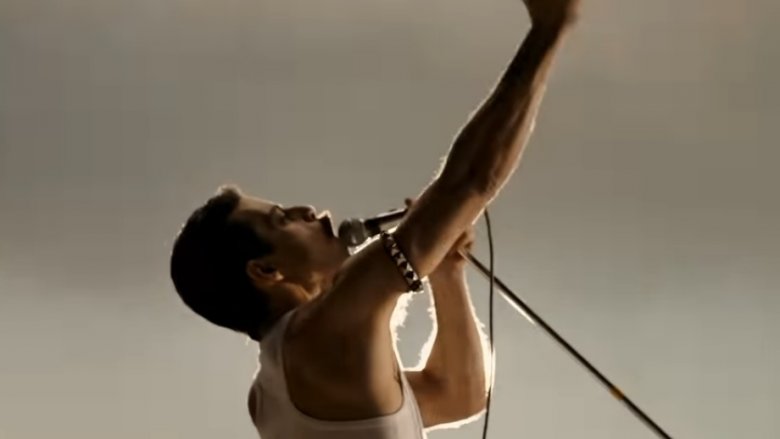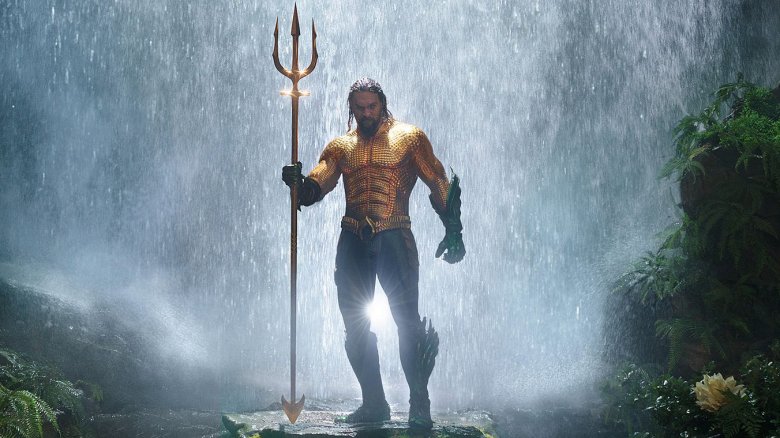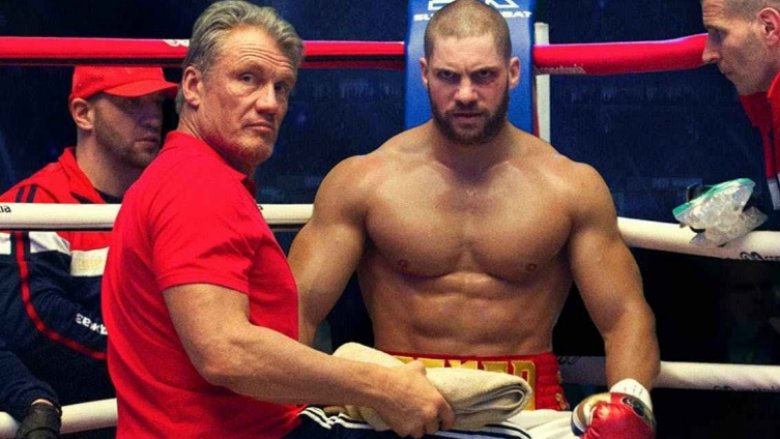The Most Iconic Movie Moments Of 2018
No matter what your genre preferences might be, it's been a pretty great year for movies. From musical dramas to nerve-shredding horror to biopics to superhero epics, 2018 has had a little something for everyone. So far, the death of theatrical releases predicted due to the rise of original streaming content has simply failed to materialize. This summer came close to an all-time domestic box office record, and—thanks to crazily strong performances from a Spider-Man antihero and a very familiar, Shatner-faced slasher—Hollywood enjoyed its best October ever.
Among 2018's theatrical releases were a good number of films we'll still be revisiting for years to come, and among those, there were several scenes that seared themselves into the cultural consciousness. Some made us well up with emotion, some outright broke our hearts, some thrilled us beyond words, and still others scared our socks off. These are the scenes we'll still be talking about next year, and the year after, and the year after that—the most iconic movie scenes of 2018.
Tom Cruise IS Ethan Hunt
Over the last two decades, the Mission: Impossible franchise has become two things: an extremely reliable adrenaline delivery system, and a continuous threat to the physical safety of its star, Tom Cruise. 2018's Mission: Impossible: Fallout was certainly no exception, and as with all M:I flicks, any one of Fallout's action set pieces could be considered among the year's most iconic. But the climactic film's helicopter chase is all the more impressive for the fact that Cruise actually learned to fly a freaking helicopter for the scene, and performed all the aerial maneuvers himself. In addition, the insane manner in which Cruise's Ethan Hunt boards the chopper, climbing up a rope attached to one of its skids as it takes off? All Cruise.
Cruise has long been known for insisting on doing all of the increasingly implausible stunts in the Mission: Impossible series himself, in seeming defiance of producers, insurers, and mortality itself. Stunt coordinator Wade Eastwood told Thrillist that the rope-climbing stunt required an exhausting six takes to complete, with two back-to-back attempts that left Cruise shivering and half-frozen (the scene was shot in New Zealand's Southern Alps, not known for its balmy temperatures). On top of this, the scene concludes with Cruise and Henry Cavill (playing the villainous John Lark) clinging to the side of a 2,000 foot cliff—no sweat for Cruise. As Eastwood put it with ever-so-slight understatement, "He's very comfortable with heights."
Return of the Shape, and the Score
Director David Gordon Green's Halloween, a direct sequel to John Carpenter's 1978 classic of the same name, had fans excited early in production. On top of Jamie Lee Curtis and Nick Castle returning to reprise their iconic roles of Laurie Strode and Michael Myers, respectively, the script by Green, Danny McBride and Jeff Fradley received the stamp of approval from Carpenter himself—and the legendary director and composer even returned to score the film, offering a brilliant new take on his instantly recognizable theme music.
The Shape's return to Haddonfield 40 years after his initial reign of terror was enough to get the pulse of any horror fan pounding, but that updated theme—appropriately titled "The Shape Returns," and composed by Carpenter with an assist from his son Cody and fellow composer Daniel Davies—drew raves before the film was even released. The familiar piano line is underlined by menacing synth stabs, which drift apart as quietly ticking, eerie percussion intrudes on the track—only to return full force, taking over the melody from the piano. If anything, it's even more haunting, purposeful and propulsive than the original theme, expertly mirroring the actions of the predatory Myers as he comes back to finish what he started. Halloween 2018 enjoyed the biggest opening ever for a horror movie and nearly broke an October record with its opening weekend—and the otherworldly presence of Castle, accompanied by the perfect score, played a big part.
"Shallow"
A Star is Born, the fourth iteration of the classic showbiz fable first told in 1937, can safely be called one of the year's biggest hits. The directorial debut of star Bradley Cooper, the picture cleaned up in a surprisingly crowded October box office, to the tune of roughly $300 million worldwide. This was largely due to the mesmerizing performance of star Lady Gaga, whose raw emotion and chemistry with Cooper can be felt in every frame—typified by the specific scene in which a star, Gaga's Ally Campana, is indeed born. Joining Cooper's Jackson Maine onstage at one of his shows, she duets with him on a tune called "Shallow"—a song which Gaga actually co-wrote, and which blew audiences right out of their chairs.
The song burned up the digital sales charts, and propelled the soundtrack album straight to number one on Billboard's chart. With its melancholy, introspective, and troubled lyrics, it's been called the defining song of 2018. Cooper's portrayal of a fading star succumbing to his demons even as his protege and lover skyrockets to worldwide fame was widely acclaimed, and Gaga proved definitively that her acting chops are not to be taken lightly—but for all of A Star is Born's heartbreak and tragedy, it's the powerful centerpiece performance of its signature tune that will linger in the memories of moviegoers.
Wakanda forever!
Avengers: Infinity War, the first part of the culmination of over ten years of Marvel Studios storytelling, was hands-down the most anticipated film of the year. It came loaded with iconic moments—the brutal death of fan favorite Loki in its opening scene, the hasty induction of Peter Parker into the Avengers, the murder of Gamora by a reluctant Thanos—but two stand out above the rest (we'll get to the second shortly). Infinity War was shot concurrently with February's Black Panther, and for the climactic battle of Wakanda, Panther's cast had a few ideas about how the Wakandans would receive Thanos' invading army.
On the Infinity War Blu-Ray, co-director Joe Russo related that he hadn't seen a single frame of Black Panther before shooting the scene. "We did not know—because we had not seen Black Panther because they were still making Black Panther—about their war chants," he said, "And they just started doing it." (Brother and co-director Anthony Russo chimed in, "Oh God, yeah.") The improvisation rolled on into T'Challa's iconic cry of "Wakanda Forever!"—a phrase which has now permanently entered the lexicon of pop culture. It was the film's single most stirring moment, and it was completely improvised by a cast who understood the culture of their fictional nation perfectly.
One legendary set
The Freddie Mercury/Queen biopic Bohemian Rhapsody could have ended one of several ways; perhaps with Mercury's recording of the vocal for "The Show Must Go On" while gravely ill, or with the singer's untimely 1991 death. Early in production, the band—who were intimately involved with the film's production—even had their sights set on Mercury's passing occurring halfway through the film, with the rest focusing on the (totally inessential) period that followed. But instead, the flick closed with the absolute high point of Mercury's and the band's career—their legendary set at the 1985 Live Aid benefit concert, which has been called possibly the greatest live rock and roll performance of all time.
While only three songs made the final cut for the film, the performance—a 20-minute set consisting of six songs—was recreated in its entirety. Amazingly, the sequence was the first one to be shot, according to cinematographer Newton Thomas Sigel. "I remember watching them rehearse three days before the shoot," he says. "They didn't know each other and those four guys really jelled, just like a rock 'n' roll band would." The faithful recreation of the iconic set quickly became iconic in its own right, bolstered by star Rami Malek's jaw-dropping channeling of Mercury—and fans will soon get to see the entire, uncut performance, which will be included as an extra when Bohemian Rhapsody is released digitally and on Blu-Ray.
A bathtub birth
A Quiet Place was one of the year's more unusual films for more than one reason. The nail-biting sci-fi thriller was the directorial debut of John Krasinski, who is well-known for bringing the sarcastic hilarity in his role as Jim in the long-running comedy series The Office. But Krasinski (who also starred alongside wife Emily Blunt) proved to have a sure directorial hand, sketching out with clarity a world in which humanity has been hunted to near-extinction by blind alien monsters which hunt by sound. The picture's resulting near-absence of a soundtrack gave it a singularly, well, quiet aesthetic, and contributed to the most harrowing childbirth sequence ever put to film.
All alone in their home, Blunt's character must endure giving birth in a bathtub while alien beasts scour the house for prey — and Blunt's performance is totally convincing for a good reason. Atypical of the rest of the film, the scene was shot in sequence over the course of five days, which was incredibly demanding. But shooting the scene in this fashion was at Blunt's suggestion—she felt it would make for a more realistic progression through the stages of childbirth, and she was right. As Krasinski told Entertainment Weekly, "It's not acting, it's like you are witnessing a moment you shouldn't be witnessing. I have a whole new respect for her."
Flipping her wig
Marvel's Black Panther was one of the biggest hits of the year, and so far, it holds the title of the most critically acclaimed film in the entire MCU. The magnetic performances of Chadwick Boseman as T'Challa and Michael B. Jordan as Erik "Killmonger" Stevens were a sight to behold, but the flick was also bolstered immensely by outstanding supporting turns from the women of the cast. Lupita Nyong'o brought the full range of her considerable talent to the role of T'Challa's ex-flame Nakia, and Letitia Wright became a breakout star as the irrepressible Shuri, but The Walking Dead's Danai Gurira simply commanded the screen as Dora Milaje chief Okoye, and never more so than in the tense casino scene, in which she, Nakia, and T'Challa attempt to corner black market arms dealer Ulysses Klaue (Andy Serkis).
Early in the scene, Nakia grumbles about having to wear a wig to blend in ("Bast willing, this will go quickly and I can get this ridiculous thing off my head," she says). When Klaue makes his presence known and the trio come under attack, she wastes no time in getting that ridiculous thing off her head—and flinging it in the face of an attacker, whom she then proceeds to dump over a balcony. The scene has been read as a stern refutation of the European standards of beauty which are often imposed on black women, lending it its iconic status...but also, it's just incredibly badass.
The Kessel Run
The spinoff flick Solo: A Star Wars Story was widely considered to be inessential, and by the standards of Star Wars, it was pretty much a flop. The film failed to burn up the box office to the degree Disney was expecting, and was met by fans and critics alike with a solid shrug. But the film's depiction of the famous Kessel Run, which Han first referred to in the original 1977 film, answered a question that's been bugging everybody for a long time: how does Han's boast ("It's the ship that made the Kessel Run in less than 12 parsecs") make any sense if "parsec" is a measure of distance, not time?
The answer had already been suggested in Extended Universe canon, but it was confirmed in Solo. In the scene in question, Han and his cohorts are racing against the clock, attempting to transport stolen hyperfuel from the planet Kessel to a refinery before it becomes unstable and explodes. It's explained that the 18-parsec "safe" route avoids the Akkadese Maelstrom, a region affected by a gravity well capable of pulling in any vessels that get too close. But Han throws caution to the wind and plots a course skirting the edge of the Maelstrom, thereby completing the run in—you guessed it—12 parsecs. Well, close enough; Chewbacca disputes the distance once the crew is safe on the planet Savareen, but Han insists that the figure is accurate "if you round down."
A major burn
Hereditary has been called one of the most truly disturbing films of the last decade or so, and with good reason. The film centers on Annie (Toni Collette), a mother who is wracked with grief when her young daughter dies in a horrifying accident. Members of a support group introduce her to the world of seances, and Annie begins to believe that her daughter's malicious spirit is attempting to gain control of her through the girl's old sketchbook. She briefly catches fire when attempting to burn the book, so she decides to sacrifice herself for the good of her family, but when she tosses the book into the fireplace, the plan backfires horribly. Her husband Steve bursts into flames instead, in one of the film's most unexpected and nerve-shredding moments.
In an interview with Variety, writer-director Ari Aster singled out the scene as one which clearly illustrates that Annie is dealing with forces way beyond her control. "This is absolutely inevitable, the family has absolutely no agency," he said. "Even that scene is meant to play as Annie's big redemptive moment...it's a beautiful gesture, but part of the cruel logic of the film is it's an empty gesture. Ultimately, it's not her choice to make. She thinks there's a design here and she can end things if she sacrifices herself. But there's no design and there are no rules."
A leap of faith
Sony's animated feature Spider-Man: Into the Spider-Verse won the hearts and minds of fans everywhere — particularly those who had been waiting for years to see Miles Morales suit up on the big screen, having originated in the Ultimate universe of the comics before being ported over to the mainstream continuity. Miles is a different kind of Spidey, full of youthful exuberance while at the same time unsure about his worthiness of the mantle, both qualities that his feature film debut played up in supremely winning fashion.
One moment in Spider-Verse seems destined to go down in Spidey lore, despite not having originated in the comics. Miles perches in costume on the edge of a building, as we hear in voiceover a previous exchange with Peter B. Parker, a middle-aged Spidey from an alternate universe. "When do I know I'm Spider-Man?" Miles asks. "You won't," Peter replies. "That's all it is, Miles — a leap of faith."
Miles takes that leap, and in doing so fully embraces his destiny as a hero. Peter's statement almost instantly became just as iconic as the defining moment of his own history, a line from Spidey's very first comics appearance: "With great power, there must also come great responsibility."
A hero emerges
Despite being a solo vehicle for one of the most (unfairly) maligned characters in DC comics, Aquaman astounded everyone by not only being quite good, but pulling in the highest worldwide gross of any film in the DC Extended Universe. Director James Wan crafted a fun, eye-popping ride, and Jason Momoa's embodiment of Arthur Curry/Aquaman is unmatched in the DCEU, with the possible exception of Gal Gadot as Wonder Woman. Fans were just a bit wary when it became known in the summer of 2018 that the flick would feature Arthur sporting his classic, rather silly-looking orange and green costume from the comics, which seemed impossible to pull off onscreen — but their worries were soundly dispelled when the moment arrived.
When Arthur attempts to retrieve the Trident of Atlan, the former King of Atlantis, he is initially rebuffed by its protector — the deep-sea leviathan known as Karathen (improbably voiced by the great Julie Andrews). But Arthur wins over the beast by virtue of his ability to understand and converse with it, and the subsequent moment when he emerges wielding the trident in full classic Aquaman regalia had fans leaping out of their seats. Indeed, perhaps nobody but Momoa could have done justice to the look, which suddenly doesn't seem so silly anymore after this one iconic shot.
Drago throws in the towel
The climactic second bout between Donnie Johnson, a.k.a. Adonis Creed (Michael B. Jordan) and Viktor Drago (Florian Munteanu) in Creed II is a brutal and well-orchestrated fight sequence. It's also a scene which brings closure to a series of events that took place in a film released over three decades prior, 1985's Rocky IV. That film is bookended by two bouts. In the first, Viktor's father Ivan kills Adonis' father Apollo in the ring after Rocky Balboa (Apollo's corner man) fails to throw in the towel in time to save him. In the second, Rocky defeats Ivan on his tome turf by slowly wearing him down while taking unbelievable punishment, rendering the unstoppable machine nothing more than a man.
Creed II's final fight mirrors both of these bouts both in terms of Adonis' strategy, and in the decision of Ivan — this time serving as his son's corner man — to throw in the towel once Viktor's defeat becomes imminent. This decision immediately humanizes both characters, as Ivan's love for his son is shown to override his desire for victory, and Viktor — at first enraged by his father's decision — realizes that conceding defeat can be more noble than winning at any cost. It's the perfect conclusion to the story of Ivan in particular, and the massively underrated Dolph Lundgren (reprising his Rocky IV role) totally sells the moment.
The Snap
The year's most iconic scene came at the climax of Avengers: Infinity War, as Thanos finally collects all of the Infinity Stones and completes his Gauntlet. The tide of the battle in Wakanda had started to turn, as Thor had arrived with the newly-forged Stormbreaker battle axe and promptly began laying waste to Thanos' armies. He then zeroes in on the Mad Titan himself, striking a devastating blow—but not a fatal one. Thanos succinctly points out, "You should've gone for the head," and then snaps his fingers.
It instantly became known simply as "The Snap," and it spelled doom for an absurd number of our most beloved characters. Audiences watched in complete horror as Black Panther, Doctor Strange, Scarlet Witch, and poor, young Peter Parker—who really didn't want to go—crumbled to dust before their eyes. Many others followed, leaving only the original Avengers (and, strangely, Rocket, the only surviving member of the Guardians of the Galaxy) standing to survey the carnage. It's the moment that spawned a thousand memes, prompted endless speculation on how our heroes may return, and left fans wondering how on Earth they were going to wait an entire year for the conclusion of the saga. Speaking with ET Online, Joe Russo indicated that he knew he was taking a chance with the audience's trust, but that "the point of the film is that, you know, sometimes villains win and not everybody makes it out alive." Point taken, Joe.



